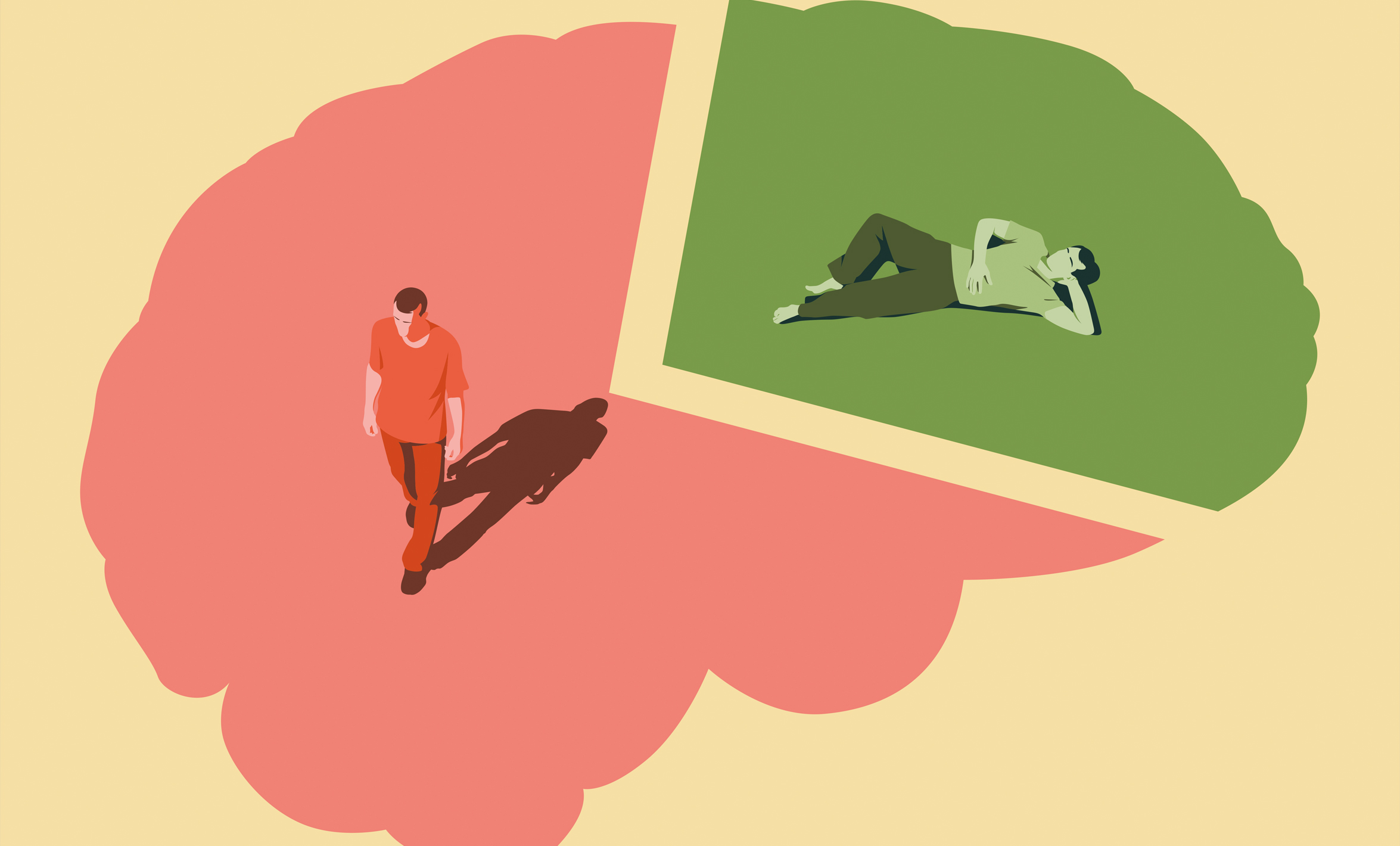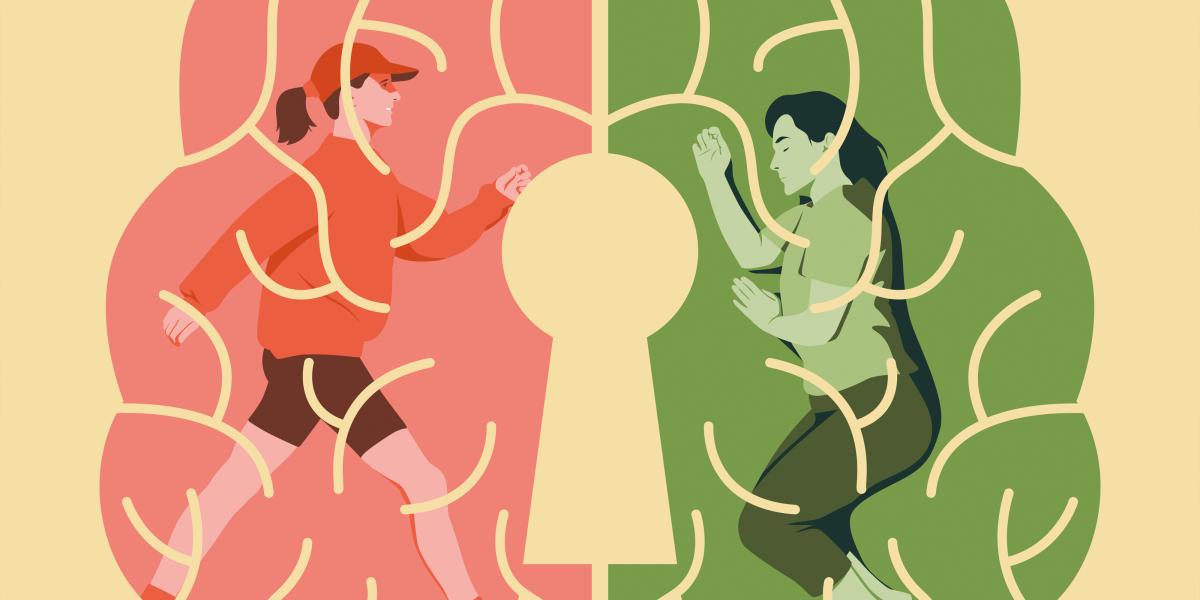Activity, Sleep & Dementia
Untangling relationships among sleep, physical activity, and brain health may suggest ways to reduce dementia risk.
Epidemiologist Jennifer Schrack has good role models when it comes to aging.
Her grandmothers both lived to be 92, and both stayed active into their final years. One walked every day and went to the gym for as long as possible, and the other kept busy playing with her grandchildren, volunteering at church, and serving meals to her senior citizen community.
“I see them as wonderfully strong, independent women,” says Schrack. “They were never unable to walk, or unable to have some independence. And I think that’s what everybody wants, right?”
Of course, many are not so lucky. An estimated 1 in 9 people over age 65 have Alzheimer’s disease, for example. Schrack, PhD ’11, MS, a professor in Epidemiology and director of the Johns Hopkins Center on Aging and Health, has spent her career researching how older adults can stay healthy as they age. She thinks movement is the key, but the relationship may not be as simple as some would think.
At the Energy, Activity & Aging (ENGAGE) Lab, she is co-leading studies that explore the connection between physical activity, rest, and dementia. For years, researchers have touted the benefits of staying active and sleeping well to promote healthy aging, and Schrack and her colleagues’ work confirms this. But their research also points to a more complex relationship—one in which physical activity and sleep are quick to change when cognitive impairment starts. Schrack hopes to leverage that link to identify new indicators of dementia risk based simply on movement, with the goal of helping those with early-stage dementia stay independent for longer.
America is an aging nation. By 2050, almost 1 in 4 adults will be over 65. By 2040, nearly 12 million Americans will be living with dementia.
“We're facing a crisis,” says Adam Spira, PhD, MA, a professor in Mental Health. Because no cure exists for dementia, many researchers are instead focusing on identifying preventive measures or early warning signs, he says.
More than two decades of research supports the notion that staying active helps prevent cognitive decline; one analysis found that higher levels of physical activity may decrease dementia risk by as much as 18%.
Multiple mechanisms likely underpin physical activity’s protective effects. Exercise spurs the body to produce important proteins, such as brain-derived neurotrophic factor, that help brain cells stay healthy and form new connections. Exercise also causes the heart to pump harder and pump more blood throughout the body.
“When you move more, blood flow to the brain improves,” says Amal Wanigatunga, PhD, MPH, an assistant professor in Epidemiology and a co-leader of the ENGAGE lab. “With improved blood flow, complex brain areas related to higher-order thinking can work better.”
But what if the relationship between physical activity and dementia isn’t a one-way street?
While Schrack and Wanigatunga have both seen the protective effects of exercise in their own research, they’re also interested in movement patterns more generally, examining how changes in daily physical activities are directly impacted by brain health.
One example is how Alzheimer’s affects walking: Many Alzheimer’s patients begin to take shorter, shuffled steps, becoming unsteady and struggling to navigate turns and obstacles. Neurodegenerative diseases not only degrade the neural pathways for memory and cognition; they also damage parts of the brain that plan and execute movement.
In studies analyzing the energy needed for older adults to walk—a useful measure of physical fitness—Schrack and Wanigatunga found that those who struggled to walk were also more likely to show signs of brain deterioration, cognitive decline later in life, and higher levels of amyloid beta, a protein whose accumulation can signal Alzheimer’s risk.
“It may be that as pathology accumulates in the brain, the way you move actually changes before your cognition becomes noticeably diminished,” says Schrack. “In that way, changes in how we move could act as early indicators.”
With more data, the researchers hope to detect subtle changes in movement patterns that create a “digital signature of cognitive decline.” To do that, they’re collecting annual physical activity data from several thousand participants in some of the longest-running studies, such as the Atherosclerosis Risk in Communities study. They provide decades of behavioral and health data, and they will continue to monitor participants for dementia into the future. Using research-grade wearable accelerometers similar to an Apple Watch or Fitbit, the researchers are gathering an entire week of movement data every year to see if certain patterns are associated with the development of dementia. (They’ve been collecting data for seven years in some cohorts and hope to continue for at least another five.)
“What we're trying to do is use physical activity as surveillance,” says Wanigatunga.
Early results are promising. In two studies led by Spira, data show that, compared to those without significant amyloid in their brains, older adults with more amyloid deposition tended to be more active in the early afternoon, with activity patterns in this time window more consistent on a day-to-day basis, compared to their counterparts without substantial brain amyloid.
While intentionally moving more is generally a good thing, these specific differences in afternoon movement may not be. Dementia is often associated with a phenomenon called sundowning, where patients become distressed and agitated in the late afternoon. Elevated afternoon physical activity in the amyloid-positive group may signal the beginning of neurodegeneration, as changes in the brain result in subtle differences in movement patterns, possibly connected to sundowning behavior. Schrack says they hope to publish further results within the next two years.

But physical activity may be only half of the equation when monitoring for early signs of dementia. Spira is also interested in changes in sleep patterns, which he measures with the same accelerometers.
Like low levels of physical activity, poor-quality sleep is also associated with higher dementia risk: People with sleep disturbances such as insomnia or sleep apnea are 19% more likely to develop dementia. And, as with physical activity, the relationship appears to go both ways.
Missing out on slow-wave sleep—the deepest stage of sleep where the body repairs itself from the day—is associated with the build-up of amyloid beta. In turn, brain changes associated with Alzheimer’s disease themselves also seem to disturb sleep, disrupting the synchronized brain waves that characterize deep sleep. This bidirectional effect creates a “vicious cycle” that may begin long before cognitive or memory problems emerge, says Spira.
Brendan Lucey, MD, a sleep and aging researcher at Washington University School of Medicine in St. Louis and a collaborator of Schrack and Spira’s, also is concerned about sleep disturbances’ impact on cognitive function. Though blood tests to measure amyloid beta levels are becoming more accurate and accessible, he says “they don't tell you about brain function. Sleep could give you an earlier signal that there’s starting to be some dysfunction in the brain.”
Since most treatments for dementia work better the sooner they’re started, such early warning signals are key. Some researchers believe many dementia drugs fail because they’re started too late, when the brain has already significantly deteriorated.
If implemented early, lifestyle changes can also stave off dementia. A 2020 Lancet commission on dementia found that among other factors, quitting smoking, treating hypertension, staying social, and, of course, physical activity could help prevent dementia in 40% of cases.
By monitoring study participants for 24 hours a day, Spira hopes to capture those subtle changes in sleep preceding cognitive decline. The accelerometers can’t capture some of the subtleties of sleep stages, but they can provide valuable data about overall rest and movement patterns. Spira describes the data as a pie sliced into three pieces: one for sleep, one for sedentary wakefulness, and one for active wakefulness. If the size of one slice changes—a participant sleeps less, for example—the size of another slice must change to accommodate.
“They’re all connected,” says Spira.
Analyzing a week’s worth of movement data presents its own challenges, though: Some wearable accelerometers churn out 240 readings per second. That means more than 145 million raw data points per participant per week.
Biostatistics associate professor Vadim Zipunnikov, PhD, MS, MA, is part of the team that helps decode the data. By analyzing changes on the sub-second level, he’s able to pick out gait-related features, and he can look for movement patterns on longer timescales to get a sense of daily movement habits.
While the team is beginning to glean some connections between movement patterns and dementia risk, Zipunnikov says they’re still a long way from a dementia warning feature on an Apple Watch or Fitbit.
But that doesn’t mean that people can’t harness the protective effects of sleep and exercise. The researchers recommend reaching out to a physician if you see major changes in either.
Wanigatunga and Schrack emphasize the importance of early, preventive messaging when it comes to movement and dementia. But current CDC recommendations—150 minutes of moderate-intensity physical activity and two days of muscle strengthening activity each week—may sound overwhelming for some.
Wanigatunga says it’s more important to make small, sustainable changes; even moving for just a few minutes a day instead of sitting is an improvement. Most people—even those with dementia or cognitive impairment—are capable of more than they think, he says.
“It’s never too late to become active,” he says. “Older adults are resilient.”
He would know. Like Schrack’s grandmothers, Wanigatunga’s grandfather lived to be nearly 100. As a child, Wanigatunga would watch him pace around the dining table to get his steps in, leaving him with a piece of wisdom he still repeats today: “If you don’t use it, you’ll lose it.”
